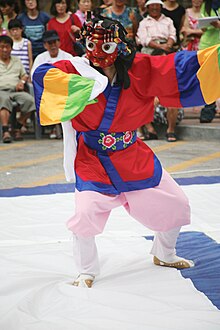Talchum
| Talchum | |
 | |
| Korean name | |
|---|---|
| Hangul | 탈춤 |
| Hanja | [none ] Error: {{Lang}}: text has italic markup (help) |
| Revised Romanization | talchum |
| McCune–Reischauer | t'alch'um |
Talchum could be characterized as a Korean dance performed while wearing a mask, miming, speaking and even sometimes singing. Although most Koreans believe that talchum refers to all mask dance dramas, it is in fact a regional term only properly applied to dances of Hwanghae Province in present-day North Korea. Dances from the Seoul or Gyeonggi Province region are known as sandae noli, whereas the dances from the southern coast are known as yayu which means field play or ogwangdae which means dance of five clowns. Korean mask dance dramas are not just dances performed by masked dancers but also include significant dramatic content with masked characters portraying people, animals and sometimes supernatural beings. These folk dramas reflect the frustrations felt by the lower classes towards the Confucian literati Yangban, due to the latter's treatment of the commoners, show the life of the common man and process social problems such as monks who ignore their precepts and men who cast off their old wives.
Characteristics
Mask dance dramas share fundamental characteristics, even though they vary considerably according to region and performer. Their basic themes are exorcism rites, ritual dances, biting satire, parody of human weaknesses, social evils and the privileged class. They appeal to the audiences by ridiculing apostate Buddhist monks, decadent upper classmen, and shamans. Another popular theme is the conflict between an old wife and a seductive concubine. With regional variations, the mask dance drama was generally performed on the First Full Moon, Buddha's Birthday on the Eighth of the Fourth Moon, Dano Festival and Chuseok. Variations may have been performed at festive state occasions or at rituals to supplicate for rain. The enthusiastic participation of the audience is the most remarkable feature of Korean mask dance drama. There is little distinction between the actors and the audience toward the end of a performance, as they join together in robust dance and bring it to a finale.[1]
Styles
Mask dance dramas have been transmitted from all parts of the country. There are about thirteen different types of mask dance drama in Korea ― Hwanghaedo province's Haeseo style, such as Bongsan Talchum, Gangnyeong Talchum, Eunyul Talchum; Gyeonggi-do province's Yangju Byeolsandae, Songpa Sandae Noli Mask Dances; Gyeongsangnam-do province's Suyeong Yayu, Dongnae Yayu, Gasan Ogwangdae, Tongyeong Ogwangdae, Goseong Ogwangdae; Gyeongsangbukdo province's Hahoe Byeolshin'gut Talnoli; Gangwon province's Gangneung Gwanno Gamyeon'guk Mask Dance; and the Namsadang (Male Itinerant Entertaining Troupe of the Northern Line) Deotboegichum Mask Dance. Among those, Bongsan Talchum and Hahoi Byeolshin'gut Talnoli are best known today.
Imaginary Creatures in Talchum
Yongno:
A monster that eats bad Yangbans. In some plays, if this type of creature eats 100 Yangban, they can go up to Heaven.[2]
Bibi:
Kind of Yongno, makes 'Bi-bi' sound. They have monster's head but a human body.[3]
Jangjamari:
Water spirits. They are very fat, play instruments, have seaweed all over their bodies. They may also be associated with fertility.[2]
In Gangneung Gwanno Gamyeon’geuk, they are associated with fertility and the summer transplanting season, dancing, wearing clothes the color of tilled earth, and decorated in rice seedlings as well as seaweed. [2]
Juji:
Juji are strange beings. They look like a birds with very small heads or can be lions.[2] Two couples jump all around. The dances between the couples may symbolize fertility.[2] However, dance between two lions could also indicate scaring away evil spirits.[2]
Gallery
-
Bongsan Talchum
-
Hahoi Byeolshin'gut Talnoli
Notes
- ^ Eckersley, M. ed. 2009. Drama from the Rim: Asian Pacific Drama Book (2nd ed.). Drama Victoria. Melbourne. p46.
- ^ a b c d e f Saeji, CedarBough (September 2012). "The Bawdy, Brawling, Boisterous World of Korean Mask Dance Dramas: A Brief Essay to Accompany Photographs" (PDF). Berkeley.edu. Berkeley University. Retrieved April 22, 2016.
- ^ "◎ Hahoe-Dong Mask Museum ◎". www.mask.kr. Retrieved 2016-04-23.
References
- Chae, Heewan. “The idea of Talchum.” Seoul: Hyunamsa, 1984
- "What is mask." Hahoe Mask Museum retrieved 29 June 2008
- Kim, Joo-yeon. "Talchum: Korean masked dance." The KNU times, 1 November 2006
- Kim, Ukdong. "The aesthetics of Talchum." Seoul: Hyunamsa, 1999
- "Korean Mask Dance Drama: Talchum." The magazine of Santa Clarita retrieved 29 June 2008
- "Mask Dances." Asian Studies presents Windows on Asia, retrieved 29 June 2008
- "Mask and Dance." Korean cultural Services NY, retrieved 25 June 2008
- "Talchum." Digital Choseonilbo retrieved 29 June 2008
- "Talchum.", retrieved 29 June 2008
- "The Nature and Origin of Masked Dance Drama." Hangukgwan, retrieved 29 June 2008





